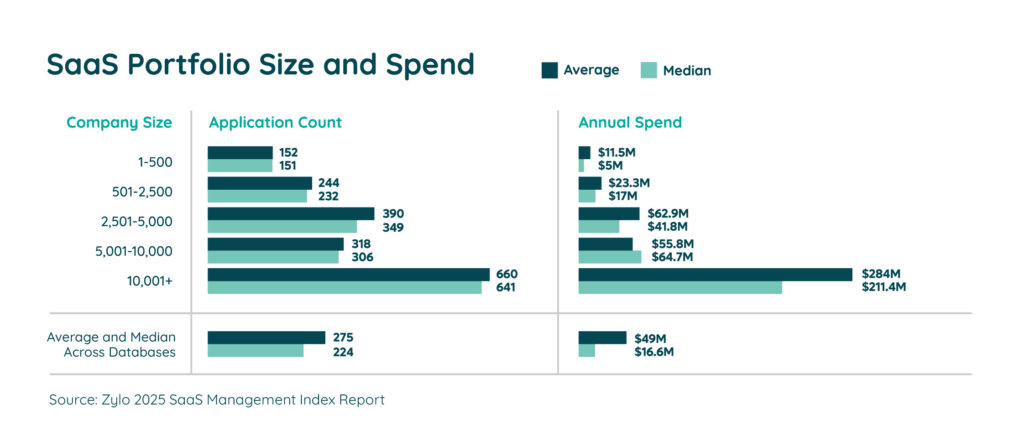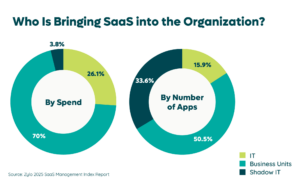Table of Contents
In the recent past, the software landscape was dominated by on-premises solutions installed on a business’ own computers and software. When on-premises was king, software asset managers (SAMs) took a hands-on approach to managing and optimizing this software.
But those days are behind us.
To be clear, on-premises solutions are still alive and well. But today, SaaS is becoming a large (and growing) share of just about every organization’s software portfolio. In fact, Gartner predicts that by 2025, 30% of organizations will rely exclusively on SaaS applications for their mission critical workflows.
The very definition of software is changing. Yet in the midst of this change, many SAMs are uninvolved with SaaS. Research tells us that a staggering 60% of Software Asset Managers are not managing their organization’s SaaS.
This is a big problem, as unmanaged SaaS growth exposes the entire organization to unnecessary costs and risks. As such, SAM leaders must make it a priority to take control of SaaS and incorporate it into their overall SAM practice.
As a starting point, every SAM leader must ask themselves these three critical questions about SaaS.
Question #1: How many SaaS applications do we have in our organization today?
If you want to take control of SaaS, the first step is to take stock of your SaaS estate. In other words you must ask how many applications are being purchased and used throughout the organization.
If you don’t know, that’s a problem. You can’t manage what you don’t know exists, and this lack of visibility can be a serious liability.
Maybe you’re not sure – but you feel confident you can make a good guess. The reality is, your best guess is likely far from reality. And if that’s the case, you’re not alone. We find that organizations typically underestimate their SaaS inventory by two to three times. Today, the average large enterprise has 660 applications and spends $284M annually.

Gartner forecasts that SaaS is expected to grown 19% in end-user spending to total $299B in 2025. In all likelihood, SaaS will soon comprise a majority of your total software spend – if that’s not already the case.
If you’re not actively monitoring your organization’s SaaS investments, chances are, you’re overspending. What’s more, each unvetted app that enters your ecosystem introduces risk. Gaining full visibility into all SaaS is critical.
Question #2: Who is managing SaaS in my organization?
As a Software Asset Manager, you’re likely involved in day-to-day management of the on-premises solutions used by your organization. But who is responsible for managing SaaS?
If you don’t know, it’s probably safe to assume that the largest overseer of your estate is the SaaS vendors themselves. If your SaaS vendors hold the power, you’re probably spending more than you should be. And, you’re exposing your organization to unnecessary (and potentially costly) risk.
If you’re not sure who’s internally managing SaaS at your organization, find out. If you find no one has been tasked with SaaS management, consider raising your hand and compiling a business case to take it on. Proactive SaaS management is proven to cut risk and cost. At a time when many businesses are looking for ways to trim costs, SaaS management may be an easy sell.
Question #3: What does the rise of SaaS mean for the future of my career?
Sure, on-premises tools aren’t going away overnight. But there’s no denying that SaaS is taking over.
Organizations are trading on-premises for SaaS for myriad reasons, including cost and convenience – among others. At the same time, a growing number of software vendors are shifting towards a SaaS model. According to Gartner, by the end of 2025, a majority of the top 20 software vendors will phase out the sale of new perpetual licenses. This is expected to increase costs by at least 35%.
SaaS differs from on-premises in a number of key ways. One key way is how it’s acquired – and who it’s acquired by.
On-premises software is typically acquired by IT. But more often than not, this isn’t the case for SaaS. Our annual SaaS Management Index found that business units are responsible for 70% of SaaS spend.

As this decentralized approach to software procurement increases, the need for on-premises software asset managers is declining. But that certainly doesn’t mean your job prospects are nil.
The future of SAM is grounded in SaaS. The best way for Software Asset Managers to future proof their careers is by raising their hands to take on SaaS Management. In fact, in the near future, we’re likely to see a whole lot more people with the job title of SaaS Manager.
SaaS, unlike on-premises software, isn’t audited. As such, SAM professionals believe there’s no need to manage it. But they couldn’t be more wrong. Sure – external audits and license compliances aren’t primary drivers for SaaS management. But the fundamentals of SAM – optimizing cost and mitigating risk – haven’t changed.
SaaS management uncovers plenty of opportunities to achieve both of those goals.
Consider the fact that 44% of provisioned SaaS licenses aren’t used in a given 30-day period. That equates to a whole lot of wasted money. With SaaS management, organizations can identify and address waste – which will deliver cost savings back to the organization.
In addition, because SaaS is often purchased by teams and individuals, many aren’t vetted by information security teams. As a result, company data sitting in those applications is unknown. This creates incredible risk – which can end up costing you. In the US, the average cost of a data breach is $4.45 million, including mitigation efforts and lost business. Proactively managing SaaS helps mitigate that risk by ensuring only safe, secure applications are used throughout the company.
SaaS is here to stay. But its growth shouldn’t be perceived as a threat to SAM leaders’ jobs. Rather, SaaS growth presents new opportunities.
SAM professionals who take a more holistic view of software management and incorporate the management of SaaS into their practice have a big opportunity to deliver value to their organizations – and pave the way as leaders.
It’s Time to Incorporate SaaS Into Your SAM Practice
Not sure where to start? As someone who’s been in your shoes, I get it. And I’m here to help.
As a first step, check out The Software Asset Manager’s Quickstart Guide to Managing SaaS. In this webinar, you’ll hear about the moment I discovered SaaS was a problem at Nike – and how I took action to tackle it.

